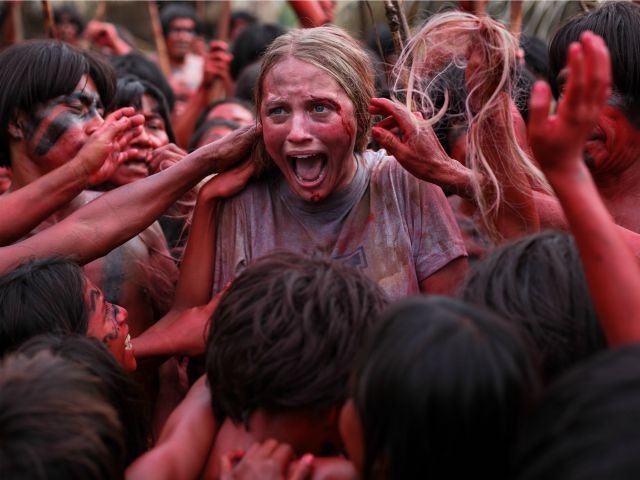[Note: minor spoilers ahead]
I had not planned on seeing horror maestro Eli Roth’s long-awaited new film The Green Inferno.
I’ve never been much for gore films. It’s not the blood and guts that gets me; I’ve seen bits and pieces of Ruggero Deodato’s 1980 classic Cannibal Holocaust, from which Roth apparently cribbed copiously for Inferno. I’ve seen (and enjoyed) the director’s Cabin Fever and Hostel Parts I and II. It’s just that excessive gore has never been my cup of tea.
Consequently, I haven’t seen many of the classic Italian “cannibal horror” exploitation films from the 1970s and 80s that Roth was paying homage to with this new film. I haven’t yet seen Umberto Lenzi’s seminal Man from the Deep River or Cannibal Ferox (though I’m told Ferox is more tame than Deodato’s Cannibal Holocaust). I was perfectly content to let the Green Inferno slide off my radar; I hadn’t even seen Black Mass yet.
Of course, I was forced to reconsider after reading what the left was saying about the film. So I caught the Sunday matinee — and I’m glad I did.
I’ll try not to spoil too much here: The Green Inferno centers on a group of American college student-activists who travel deep into the Peruvian jungle to save it from the crush of coming bulldozers. Freshman Justine (a superb Lorenza Izzo) has never been interested in campus activism; that is, until she meets the charismatic Alejandro (Ariel Levy), who’s assembled a group of like-minded students in a plan to save the Amazonian forest and its indigenous people from the dual threats of deforestation and a hostile militia.
Justine’s roommate, Kaycee (Sky Ferreira,) is highly skeptical of the activists’ motivation: “The only thing they care about is looking like they care,” she says, later on adding: “Activism is so freaking gay.”
But the group is soon off into the jungle, armed with nothing more than cell phones. They confront the bulldozers and the gun-waving construction crew, live-stream the whole showdown with their phones, and eventually come away victorious. Alejandro shares the good news over beers on the plane ride home: “We’re trending worldwide! We’re on the front page of Reddit!”
Then the plane crashes, the tribe catches up with the stranded activists, and the flesh-eating, eyeball-gouging, limb-chopping fun begins.
But it was the “social justice warrior as naive victim of his/her own activism” angle that immediately intrigued me, way more than the blood and guts (although true gore-hounds will NOT be disappointed). In an interview with IGN way back in 2013, when the film was stuck in distribution hell, Roth said he took inspiration from social media “slacktivism” and groups like Occupy Wall Street when crafting the plot:
It’s about these kids that get so caught up in a cause because it’s sexy, they don’t even really take the time to learn what it’s about. And you think of all these 100m YouTube views, and all these t-shirts sold and all those mugs. And then the guy’s jerking off in the street and Kony’s still out there, and it didn’t mean sh*t. Nothing. Absolutely nothing. It was completely useless. OK yes, it raised awareness. But so what? It didn’t catch him. It didn’t stop him. I think that people want to fix things instantly, and they can use their phones to do that now.
Roth also revealed that real indigenous people played the parts of the cannibalistic tribe in the film.
We scouted in the summer-time and went up the river for hours and hours and found this village where there was no electricity, no running water, grass huts. Ten people in a shack. And it looked incredible; it looked like a village from another time, so we asked if we could film there. But I was told that we have to tell them what a movie is because they have no idea. They’ve never seen one. They’ve never even seen a television. So they went back with a television and a generator and showed the village Cannibal Holocaust, which I couldn’t believe. And the villagers – thank god – thought it was a comedy. The funniest thing that they’d ever seen. And they wanted to play cannibals in the movie. So we had the entire village acting in the film. And they speak Quechua – which is like another language from another time.
Following the film’s release last weekend, the left was, predictably, branding the film “racist” for its portrayal of the Amazon’s indigenous people. The Wrap‘s Inkoo Kang called the movie a “racially reprehensible work that exploits one of the world’s most powerless peoples.” Tribal rights attorney Tara Houska penned a piece for The Huffington Post decrying the film’s “incredibly offensive depiction of indigenous people.”
The American moviegoing public, and horror fans in particular, didn’t exit the theater and collectively sigh, “Wow, Peru’s indigenous peoples are all a bunch of cannibalistic freak shows.” They simply believed, correctly, that those fictional villagers in the film were cannibalistic freak shows, and even then, no one could blame the villagers: who’d want to deal with a bunch of self-important, snooty American social justice warriors?
If there is a villain in a film (and there are in most good ones), the left needs to find a way in which they’re portrayed unfairly, or not given enough screen time, or “misunderstood.” After all, Huffington Post “Impact thought pieces” don’t write themselves.
Bottom line: if gory horror films are your thing, or if you’ve been waiting for the reemergence of the cannibal exploitation sub-genre of horror flicks, give The Green Inferno a shot.

COMMENTS
Please let us know if you're having issues with commenting.